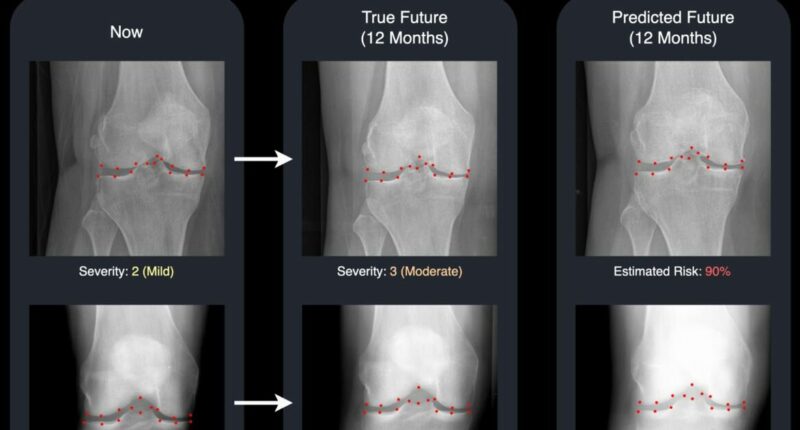Share this @internewscast.com
Scientists in the UK have developed an innovative AI system that uniquely predicts the future appearance of osteoarthritis patients’ knees, allowing physicians to better manage the condition. Osteoarthritis, a degenerative disease of the joints, impacts over 500 million people globally and is a primary cause of disability among the elderly.
A groundbreaking study from the University of Surrey has introduced a technology that utilizes advanced machine learning techniques to create a realistic “future” X-ray, coupled with a risk score indicating the disease’s progression in the knee. This dual output provides doctors and patients with a clear and visual outlook on how the condition might evolve over time.
Training with nearly 50,000 knee X-rays from close to 5,000 patients, the system ranks as one of the most expansive osteoarthritis datasets globally. It surpasses similar AI tools in predicting the progression of the disease, achieving results about nine times faster and in a more streamlined format.
The speed, scale, and precision of this system could significantly enhance its adoption in practical clinical environments. This study was presented at the International Conference on Medical Image Computing and Computer Assisted Intervention.
David Butler, leading post-graduate researcher at the University of Surrey’s Centre for Vision, Speech and Signal Processing (CVSSP) and Institute for People-Centred AI, noted: “Typically, medical AI tools provide a numeric prediction with little context.
“Our system goes a step further by not only assessing the likelihood of knee deterioration but also generating a realistic image of what the future condition might appear like.”
“Seeing the two X-rays side by side – one from today and one for next year – is a powerful motivator.
“It helps doctors act sooner and gives patients a clearer picture of why sticking to their treatment plan or making lifestyle changes really matters.
“We think this can be a turning point in how we communicate risk and improve osteoarthritic knee care and other related conditions.”
Osteoarthritis is the most common type of arthritis, characterised by pain, stiffness, and swelling in joints due to the breakdown of protective cartilage.
It is more common in older adults, particularly in the knees, hips, and hands, though it can affect other joints like the spine and neck.
Using an advanced generative model, called a diffusion model, the Surrey system generates a “future” version of a patient’s knee X-ray and highlights 16 key points in the joint.
These points add transparency by showing which areas the AI is monitoring for changes, making the system easier for clinicians to understand and trust.
In the future, this research could pave the way for similar tools in other chronic conditions for example, predicting lung damage in smokers or tracking heart disease progression, giving doctors and patients the same kind of visual insight and opportunity to act early.
The team is also seeking partnerships to bring the technology into real-world clinical settings.
Gustavo Carneiro, Professor of AI and Machine Learning at Surrey’s Centre for Vision, Speech and Signal Processing (CVSSP), said: “Earlier AI systems could estimate the risk of osteoarthritis progression, but they were often slow, opaque and limited to numbers rather than clear images.
“Our approach takes a big step forward by generating realistic future X-rays quickly and by pinpointing the areas of the joint most likely to change.
“That extra visibility helps clinicians identify high-risk patients sooner and personalise their care in ways that were not previously practical.”















